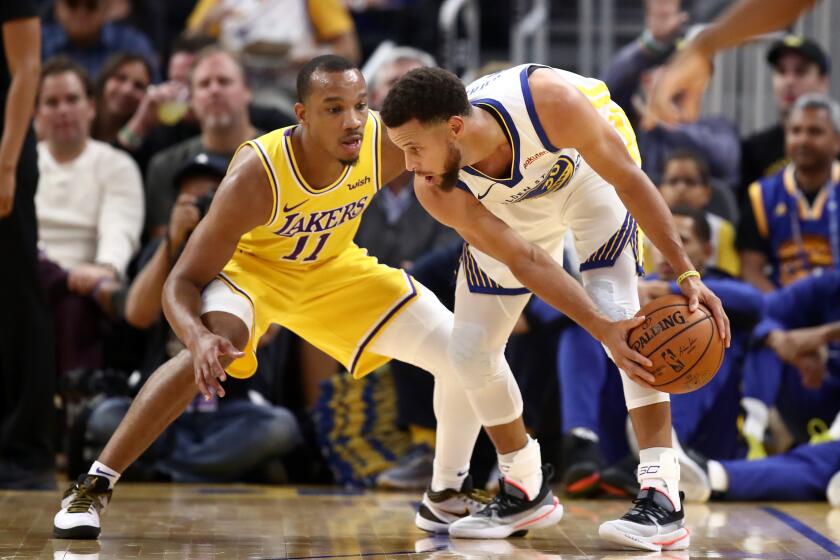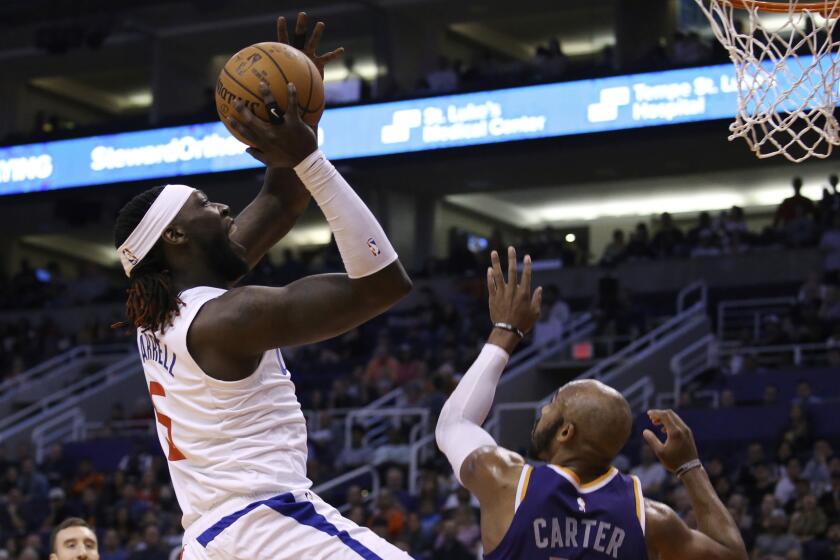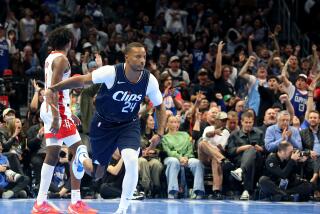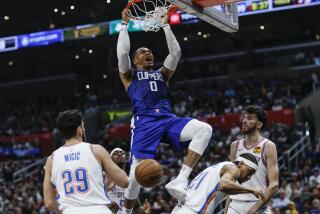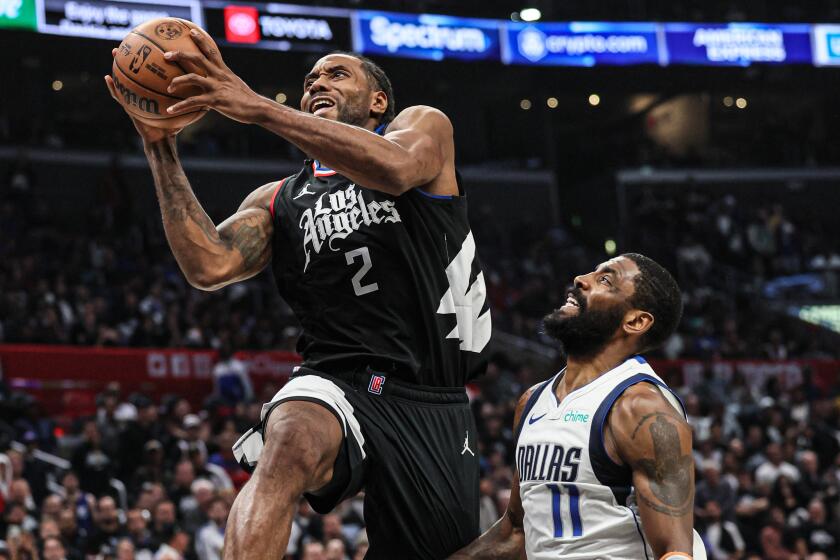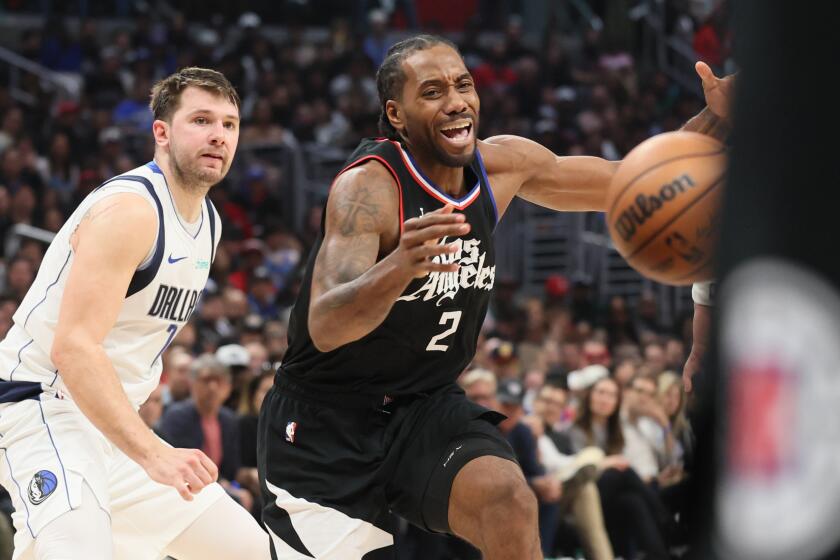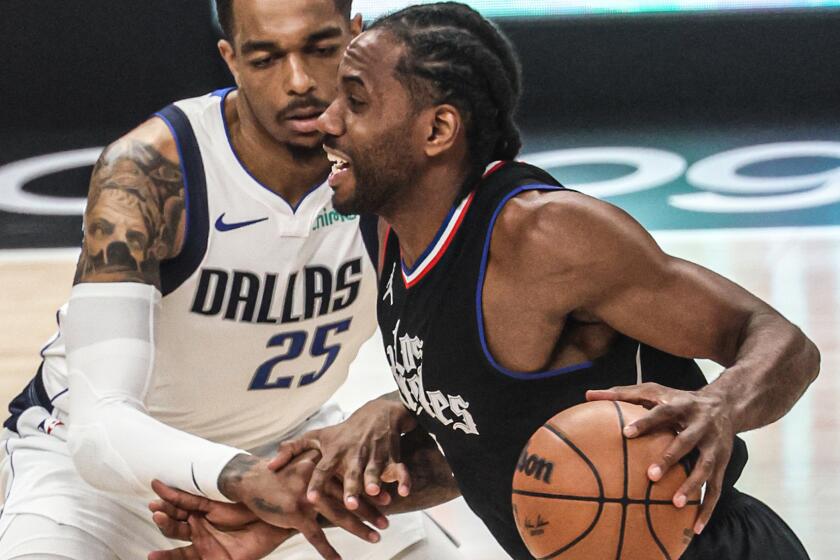Patrick Patterson tries to fit in with Clippers’ plans
Through three games, Clippers forward Patrick Patterson has averaged six three-point attempts — nearly three times his career average.
That is not a misprint. That is his team’s plan in action.
Upon joining the Clippers in August shortly after reaching a buyout with Oklahoma City, the 30-year-old forward was given a brief job description by coach Doc Rivers: Just shoot the ball.
“That,” Patterson said, “is my dream job.”
One season after losing his starting job with the Thunder while making a career-low 33.6% of his three-pointers and 37% from the field, Patterson is shooting 44% from behind the arc and 42% from the field. In Thursday’s victory against Golden State, he attempted 10 three-pointers and made a career-high six. Such early results have represented a revival of the form that have made him a career 37% shooter from deep.
“Had to get his confidence back,” said guard Patrick Beverley, a teammate of Patterson’s in Houston, as well. “On this team, we going to get you all the confidence you need and he’s been phenomenal.”
Rivers is not the first coach to tell Patterson that his main offensive contribution would be three-point shooting. That honor belonged to then-Houston coach Kevin McHale, seven years ago, before Patterson’s third NBA season.
“Him telling me, ‘All I want you to do is shoot threes,’ it was like, ‘OK, man — so I have to change my game?’” Patterson said. “It was a little disappointing, a little frustrating.”
Four of the five Lakers’ starters in their two games this season knew they’d be announced as starters over the Staples Center speakers.
To that point his ventures beyond the three-point arc in a half-court offense were rare. At Kentucky, where he was one of the nation’s top recruits, and during his first two seasons in the NBA, when he attempted all of five three-pointers in 116 games, Patterson lived close to the rim.
Patterson took McHale’s advice as a signal that his career’s longevity would hinge on adapting offensively. He averaged nearly two three-pointers per game the next season but also attempted nearly seven shots inside the arc, too. By his fifth season, Patterson averaged more threes than twos for the first time.
“Coming into that season, realizing that my opportunities to post the ball, post up and get twos, stuff that I’d been doing my whole life, I knew it would be limited,” he said. “The game was changing. People were shooting more threes.
“I look at as there’s 1% and there’s 99%. The 1% is Kawhi [Leonard], [Paul George], Lou [Williams], LeBron [James], so forth. The 99% is the rest of the NBA. Then you have to try to find your niche and try to find a way to survive and last in the league. For me, it’s three-point shooting and defense. To come into a situation, to a role, where that’s literally all they want from me and ask of me, I just try to do that.”
Three seasons ago in Toronto, when Patterson made 37% of his then-career-high 3.9 three-pointers per game, spot-up shots accounted for 54% of all his attempts, according to Synergy. In Oklahoma City, his share of spot-ups dipped to 43.6% in 2017-18 and 32% last season as his accuracy also decreased.
Montrezl Harrell scored 28 points and Kawhi Leonard added 27, but the Clippers fell 130-122 to the Suns as their 12-game winning streak in the series ended.
Oklahoma City “had him doing too much,” Rivers said. “He didn’t lose being a shooter. I just thought over the last couple of years you could see him taking different shots. Shots off the dribble. That makes you inefficient.”
In signing Patterson this summer, the Clippers (2-1) trusted that their stars such as Leonard and George would draw defensive attention away from the team’s other shooters and lead to more spot-up opportunities. Three of Leonard’s 24 assists this season have gone to Patterson.
“I think when a coach tells you, ‘Shoot the ball every time,’ I mean, that would hopefully give you some … confidence,” Rivers said. “There are going to be some games where he doesn’t make shots but that’s OK and the fact that he knows that, I think, probably will help him in the long run.”
The 6-foot-9 Patterson started each game at power forward, though that is subject to change in Rivers’ self-described “sliding” lineup where only Leonard and George, when healthy, hold guaranteed spots. Rivers has called 6-8 Maurice Harkless likely the best fit to start alongside the superstar tandem, upon George’s debut following his recovery from offseason shoulder surgeries, given the trio all can guard multiple positions, making it easier to switch defensively.
JaMychal Green, another 6-9 forward, meanwhile, has made 69% of the 4.3 three-pointers he’s attempted each game.
For now, Patterson has stuck with a starting lineup featuring Beverley and Leonard, guard Landry Shamet and center Ivica Zubac. Rivers has praised Patterson’s serious approach to his work, and defensively the 10th-year veteran blocked a shot at the rim and drew a charge Saturday against Phoenix. The defensive plays helped on a night where he made one of his five three-pointers.
“He brings energy. Obviously, defense and some smarts on both ends of the floor,” Leonard said. “He’s a communicator. Spacing out the floor well. He’s doing a good job.”
UP NEXT
VS. CHARLOTTE
When: 7:30 p.m. Monday
On the air: TV: Prime, NBA TV; Radio: 570
Update: The Hornets are playing for the second consecutive night after facing the Lakers on Sunday. Forward Nicolas Batum is out at least two weeks after fracturing the third finger of his left hand in the team’s season opener. Rookie P.J. Washington made seven three-pointers against Chicago on Wednesday, an NBA record for three-pointers in a first pro game. He also set a franchise record for points in a debut with 27. After signing a three-year contract worth $58 million in July, guard Terry Rozier averaged 9.0 points and 8.0 assists, while shooting 42% from three-point range, with 3.0 turnovers in his first two games.
More to Read
Get our high school sports newsletter
Prep Rally is devoted to the SoCal high school sports experience, bringing you scores, stories and a behind-the-scenes look at what makes prep sports so popular.
You may occasionally receive promotional content from the Los Angeles Times.

